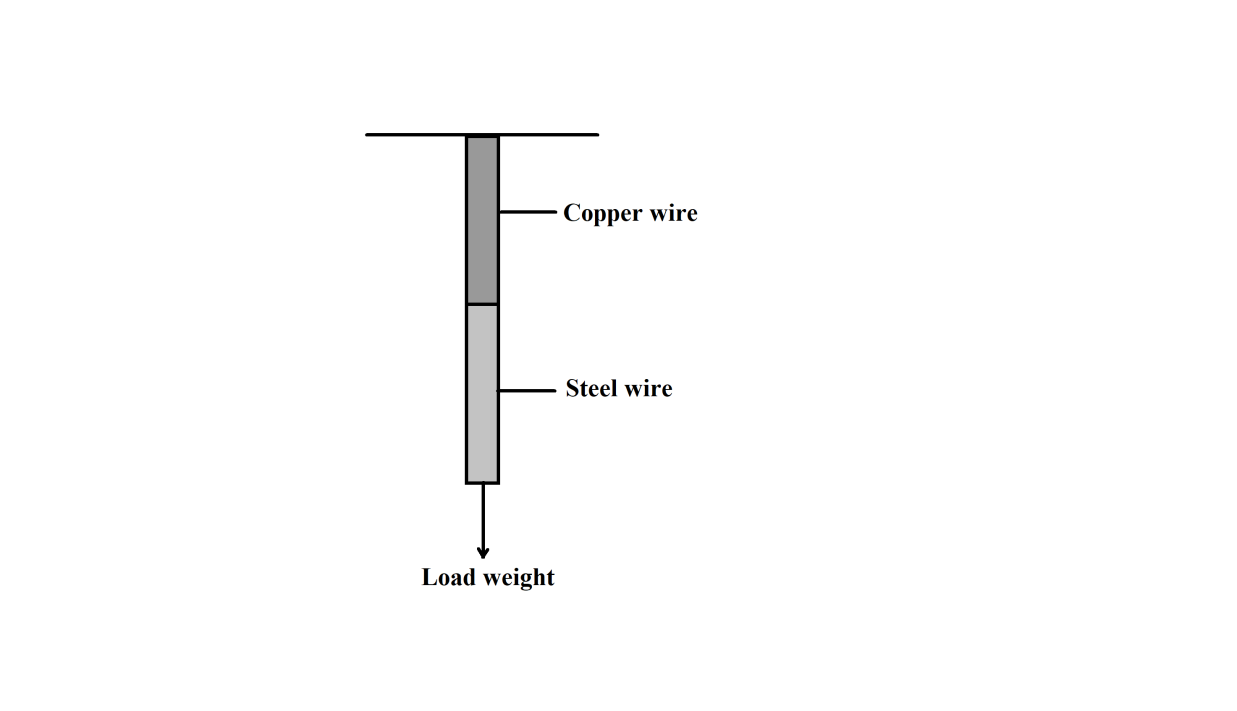Answer
334k+ views
Hint: For determining the relation between the extensions in the two wires, we will use the concept of Young’s Modulus. As the length and area of cross-section of both the wires are the same, therefore, we will obtain a relation between the ratio of extension in the wire and their respective young’s modulus.
Formula used:
$Y=\dfrac{F}{\dfrac{AL}{\Delta l}}=\dfrac{F\Delta l}{AL}$
Complete step by step solution:
We are given that the length of Copper wire is equal to the length of Steel wire, and they both have the same area of cross section. For finding the relation in the extension in the wires, we will use the equation of Young’s Modulus. Young’s Modulus, being an internal property of an object, does not depend upon the shape and size of the body. The value of Young’s modulus is kept the same for a particular material. We have the values of Young's modulus for both the wires.

$\begin{align}
& {{L}_{Cu}}={{L}_{Steel}} \\
& {{A}_{Cu}}={{A}_{Steel}} \\
\end{align}$
Let’s say the increase in lengths of the individual wires be $\Delta {{l}_{Cu}}$and $\Delta {{l}_{Steel}}$
Total increase in the length of composite wire is$\Delta {{l}_{total}}$, and $\Delta {{l}_{total}}=2.4mm$
It means,
$\Delta {{l}_{Cu}}+\Delta {{l}_{Steel}}=\Delta {{l}_{total}}=2.4mm$
Also, young’s modulus of elasticity $Y=\dfrac{Fl}{A\Delta l}$
It gives, $\Delta l=\dfrac{FL}{AY}$
Now,
$\Delta {{l}_{Cu}}=\dfrac{F{{L}_{Cu}}}{{{A}_{Cu}}{{Y}_{Cu}}}=\dfrac{FL}{A{{Y}_{Cu}}}$
$\Delta {{l}_{Steel}}=\dfrac{F{{L}_{Steel}}}{{{A}_{Steel}}{{Y}_{Steel}}}=\dfrac{FL}{A{{Y}_{Steel}}}$
Dividing the above two equations,
$\dfrac{\Delta {{l}_{Cu}}}{\Delta {{l}_{Steel}}}=\dfrac{{{Y}_{Steel}}}{{{Y}_{Cu}}}$
Putting values of ${{Y}_{Steel}}$and${{Y}_{Cu}}$,
$\dfrac{\Delta {{l}_{Cu}}}{\Delta {{l}_{Steel}}}=\dfrac{2\times {{10}^{11}}}{10\times {{10}^{10}}}$
$\dfrac{\Delta {{l}_{Cu}}}{\Delta {{l}_{Steel}}}=2$
The extension in Copper wire will be double of the extension in steel wire.
As we have,
$\Delta {{l}_{Cu}}+\Delta {{l}_{Steel}}=\Delta {{l}_{total}}=2.4mm$
Put\[\Delta {{l}_{Cu}}=2\Delta {{l}_{Steel}}\]
We get,
$\begin{align}
& \Delta {{l}_{Steel}}=0.8mm \\
& \Delta {{l}_{Cu}}=2\Delta {{l}_{Steel}}=1.6mm \\
\end{align}$
Therefore,
$\Delta {{l}_{Steel}}$is $0.8mm$and $\Delta {{l}_{Cu}}$is $1.6mm$
Hence, the correct option is C.
Note: Students should keep in mind that Young’s modulus of a material is a fundamental property of every material that cannot be changed. For a particular material, such as Copper and Steel, young’s modulus is kept constant. If two materials have the same length and area of cross-section, the ratio of extension in the length of the wires will be inversely proportional to the ratio of young’s modulus of the two materials.
Formula used:
$Y=\dfrac{F}{\dfrac{AL}{\Delta l}}=\dfrac{F\Delta l}{AL}$
Complete step by step solution:
We are given that the length of Copper wire is equal to the length of Steel wire, and they both have the same area of cross section. For finding the relation in the extension in the wires, we will use the equation of Young’s Modulus. Young’s Modulus, being an internal property of an object, does not depend upon the shape and size of the body. The value of Young’s modulus is kept the same for a particular material. We have the values of Young's modulus for both the wires.

$\begin{align}
& {{L}_{Cu}}={{L}_{Steel}} \\
& {{A}_{Cu}}={{A}_{Steel}} \\
\end{align}$
Let’s say the increase in lengths of the individual wires be $\Delta {{l}_{Cu}}$and $\Delta {{l}_{Steel}}$
Total increase in the length of composite wire is$\Delta {{l}_{total}}$, and $\Delta {{l}_{total}}=2.4mm$
It means,
$\Delta {{l}_{Cu}}+\Delta {{l}_{Steel}}=\Delta {{l}_{total}}=2.4mm$
Also, young’s modulus of elasticity $Y=\dfrac{Fl}{A\Delta l}$
It gives, $\Delta l=\dfrac{FL}{AY}$
Now,
$\Delta {{l}_{Cu}}=\dfrac{F{{L}_{Cu}}}{{{A}_{Cu}}{{Y}_{Cu}}}=\dfrac{FL}{A{{Y}_{Cu}}}$
$\Delta {{l}_{Steel}}=\dfrac{F{{L}_{Steel}}}{{{A}_{Steel}}{{Y}_{Steel}}}=\dfrac{FL}{A{{Y}_{Steel}}}$
Dividing the above two equations,
$\dfrac{\Delta {{l}_{Cu}}}{\Delta {{l}_{Steel}}}=\dfrac{{{Y}_{Steel}}}{{{Y}_{Cu}}}$
Putting values of ${{Y}_{Steel}}$and${{Y}_{Cu}}$,
$\dfrac{\Delta {{l}_{Cu}}}{\Delta {{l}_{Steel}}}=\dfrac{2\times {{10}^{11}}}{10\times {{10}^{10}}}$
$\dfrac{\Delta {{l}_{Cu}}}{\Delta {{l}_{Steel}}}=2$
The extension in Copper wire will be double of the extension in steel wire.
As we have,
$\Delta {{l}_{Cu}}+\Delta {{l}_{Steel}}=\Delta {{l}_{total}}=2.4mm$
Put\[\Delta {{l}_{Cu}}=2\Delta {{l}_{Steel}}\]
We get,
$\begin{align}
& \Delta {{l}_{Steel}}=0.8mm \\
& \Delta {{l}_{Cu}}=2\Delta {{l}_{Steel}}=1.6mm \\
\end{align}$
Therefore,
$\Delta {{l}_{Steel}}$is $0.8mm$and $\Delta {{l}_{Cu}}$is $1.6mm$
Hence, the correct option is C.
Note: Students should keep in mind that Young’s modulus of a material is a fundamental property of every material that cannot be changed. For a particular material, such as Copper and Steel, young’s modulus is kept constant. If two materials have the same length and area of cross-section, the ratio of extension in the length of the wires will be inversely proportional to the ratio of young’s modulus of the two materials.
Recently Updated Pages
Basicity of sulphurous acid and sulphuric acid are

Assertion The resistivity of a semiconductor increases class 13 physics CBSE

Three beakers labelled as A B and C each containing 25 mL of water were taken A small amount of NaOH anhydrous CuSO4 and NaCl were added to the beakers A B and C respectively It was observed that there was an increase in the temperature of the solutions contained in beakers A and B whereas in case of beaker C the temperature of the solution falls Which one of the following statements isarecorrect i In beakers A and B exothermic process has occurred ii In beakers A and B endothermic process has occurred iii In beaker C exothermic process has occurred iv In beaker C endothermic process has occurred

The branch of science which deals with nature and natural class 10 physics CBSE

What is the stopping potential when the metal with class 12 physics JEE_Main

The momentum of a photon is 2 times 10 16gm cmsec Its class 12 physics JEE_Main

Trending doubts
Difference between Prokaryotic cell and Eukaryotic class 11 biology CBSE

Difference Between Plant Cell and Animal Cell

Select the word that is correctly spelled a Twelveth class 10 english CBSE

Fill the blanks with the suitable prepositions 1 The class 9 english CBSE

What is the z value for a 90 95 and 99 percent confidence class 11 maths CBSE

Give 10 examples for herbs , shrubs , climbers , creepers

What organs are located on the left side of your body class 11 biology CBSE

What is BLO What is the full form of BLO class 8 social science CBSE

Change the following sentences into negative and interrogative class 10 english CBSE



